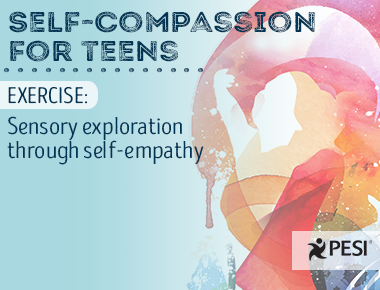Self-Compassion for Teens
A sensory activity worksheet

Do you ever feel overwhelmed with the challenges teens present with? Nationwide we’re seeing high rates of teen suicidality, self-harm, substance abuse, and struggles with school. We can help relieve teen suffering when we arm ourselves with tools like self-compassion.
Self-compassion for teens reduces suffering and stress through mindful awareness, self-kindness, interconnectedness, as well as the willingness to take action to relieve suffering.
So, how can we cultivate self-compassion practices with teens? A good place to start is with self-empathy and self-regulation.
Self-empathy begins with mindful awareness of yourself, but goes deeper. It starts with paying attention to your own inner needs, wants, desires, sensitivities, aversions, as well as strengths and weaknesses. Practicing self-empathy allows us to turn inward with open balanced awareness, free of judgment, and full of acceptance.
Using self-empathy, we can then begin to explore sensory sensitivities, sensory integration, and self-regulation.
According to A. Jean Ayres (2005), sensory integration is how people make sense of, and use, information about their bodies and the environment around them. When the nervous system organizes this information well, teens are self-regulated. When sensory information is either over- or underwhelming, teens can expend excessive amounts of energy trying to cope.
Since sensory integration is an unconscious phenomenon, gaining awareness of the effects allows teens to respond to situations in self-compassionate ways. Moreover, sensory integration forms the basis for learning and relating.
The following practice is an inventory to help teens discover if they have sensory sensitivities.
Practice: Use the Sensory Activities Log worksheet to explore sensory information with self-empathy.
We usually think about five-seven senses, but there are at least 11:
- Movement (vestibular system)
- Position in space (proprioception)
- Motor skills and planning
- Touch
- Visual perception (sight)
- Auditory language and hearing (sound)
- Smell
- Taste
- Interoception (sensing the gut, and everything inside the body)
- Relatedness (the sense of knowing what is happening in relationship with others)
- Mind (all mental activity, including thoughts,beliefs, dreams, perceptual aberrations, etc..)
Learning about sensory sensitivities is just a small step in becoming more mindful about oneself so that self-kindness can flow. You can learn more about self-compassion for teens in my new book: Self-Compassion for Teens: 129 Activities & Practices to Cultivate Kindness.
Download the Sensory Activities Log
Topic: Self-Compassion
Tags: Mindfulness | Self-Compassion | Self-Empathy | Self-Regulation




